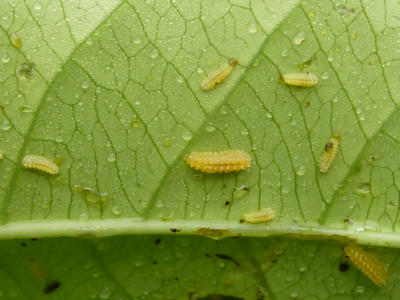Red Pedilia Flea Beetle (Pedilia "red")
This species appears to specialize on P. pittieri only, although in the garden where P. pittieri is close to other species I have seen adult Pedilia chewing tiny holes in the leaves of P. ambigua and P. oerstedii. These include chew holes on the margins of the leaves as well as in the leaf blades. According to Erika Deinert it appears to be nearly identical (except for color) to the Pedilia sirena found on the Osa Peninsula in Southwestern Costa Rica. That species, an orange-yellow color, is also a specialist on P. pittieri. A few orange yellow individuals have been found on P. pittieri at La Selva, supporting the idea that these may be one species with two color morphs. The larvae also seem to vary in color, possibly depending on pigments in the host plant stems, and even the frass may be reddish brown on some stems (see photos below). Also, Yellow Ptocadica looks a lot like the yellow form of Pedilia that feeds on P. pittieri. Ptocadica are somewhat longer with a longer pronotum, and the legs and basal antenna segments are melanized. Pedilia legs and first antenna segments are clear and unpigmented or reddish in color.
Red Pedilia adults may be consistently found year-round on the large garden P. pittieri plant that grows next to the lab buildings at La Selva. This plant, a remnant of a Passiflora garden planted 40 years ago, is large and robust, and supports a large colony of Ectatomma tuberculatum ants. The plant has between 20 and 50 adults present at any given time, and they may often be found feeding on the new growth shoots that erupt from the plant every few days. Adults and young larvae prefer the light green, waxy, soft new growth, and the youngest full-sized leaves are often peppered with feeding holes (adults) or scrapings (larvae). Measurement of HCN production by crushed leaves tells us that young leaves have about 5 micromoles HCN per gram leaf tissue (mM/g), and that the amount rises to about 20 mM/g as the leaves age. After about one month the leaves begin to harden and, even though cyanogenesis drops to 5-10 mM/g, the leaves become less palatable. However, at this time the epidermis of the stem and petioles takes on a reduced HCN content, and becomes preferred for the adults and larvae. It is possible that, by scraping the lower leaf tissue, the larvae and adults may avoid release of HCN. Adults mate on the host plant. I have seen Pedilia feeding damage on some of the wild P. pittieri plants at La Selva, even though I have not found live beetles.
Larvae are more cylindrical and elongate than Ptocadica larvae, though the protuberances are similar in size. Also, there are no balloon organs, also like Ptocadica but unlike Disonycha.
Feeding trials in which Pedilia larvae were placed in containers with different Passiflora species reveal Pedilia to be a feeding specialist. The only species they would eat besides P. pittieri were P. biflora, P. arbelaezii, and P. costaricensis, and they fed poorly on those. When placed on P. lobata, Pedilia larvae became impaled on the hooked trichomes and died.
I placed 5 Red Pedilia adults in a closed chamber with a P. pittieri leaf to see if they would produce HCN gas while feeding. They all died within 2-3 days without feeding. I was not able to detect any HCN gas. This experiment needs to be repeated.



